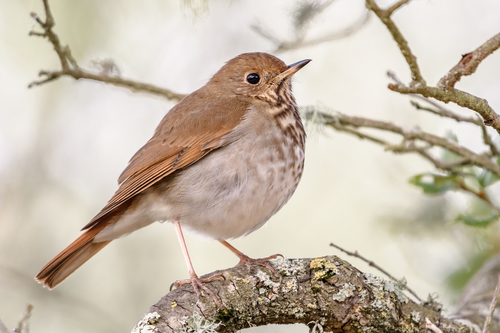
Hermit Thrush
The Hermit Thrush (Catharus guttatus) is a small, North American songbird renowned for its ethereal, flute-like song, often considered one of the most beautiful bird vocalizations. It plays a vital role in its forest ecosystem, primarily as an insectivore during the breeding season and a frugivore (fruit-eater) during migration and winter. This helps to control insect populations and disperse seeds. While not typically associated with strong cultural symbolism, its song has inspired poets and musicians, often representing solitude, peace, and the beauty of nature.
15-18 cm
Length
25-30 cm
Wingspan
Least Concern
Conservation Status
Distribution
Breeds across North America, from Alaska and Canada south through the western United States and into the Appalachian Mountains. Migrates south to winter in the southern United States, Mexico, and Central America. Altitudinal range varies from sea level to over 3,000 meters.
Lifespan
Up to 8 years in the wild, though typically shorter. Records of up to 10 years in captivity.
Hermit Thrush's Habitat
Habitat Types
Coniferous forests, Mixed woodlands, Deciduous forests, Boreal forests, Forest edges
Climate Zones
Temperate, Boreal, Subarctic
Adaptations
Their relatively short wings and long legs are well-suited for maneuvering through dense undergrowth. They are adapted to foraging on the forest floor.
Variations
There are numerous recognized subspecies (around 12) that differ subtly in plumage coloration and song. These variations are most pronounced across different geographic regions, such as coastal vs. interior populations.
Appearance
Breeding Plumage
Generally similar year-round, but breeding plumage may be slightly brighter.
Seasonal Feather Changes
Limited seasonal variation.
Sex Based Plumage Differences
Males and females are visually similar.
Notable Features
Reddish-brown tail, Spotted breast, White eye-ring, Brownish-gray upperparts
Diet and Feeding
Primary Foods
Insects, Spiders, Berries, Small fruits
Foraging Behavior
Primarily forages on the ground, hopping and scratching among leaf litter to uncover prey. Will also glean insects from foliage and occasionally hawk insects in the air.
Specializations
No highly specialized feeding adaptations, reflecting their generalist diet.
Seasonal Diet Variations
Diet shifts seasonally. Primarily insects and other invertebrates during the breeding season, switching to a greater proportion of fruits and berries during migration and winter.
Behavior
Social Structure
Generally solitary or in pairs during the breeding season. May form small flocks during migration and winter.
Communication
Complex, flute-like song, Sharp 'chuck' calls, High-pitched 'seee' calls
Migration
Nocturnal migrant. Travels at night, often in mixed-species flocks. Migration routes and timing vary depending on breeding location.
Territorial or Group Behaviors
Males are territorial during the breeding season, defending their nesting area through song and aggressive displays. Outside of breeding, they are less territorial.
Conservation
Threats
Habitat loss and fragmentation (especially on wintering grounds), Collisions with buildings and other structures during migration, Climate change (potential shifts in habitat and food availability), Pesticide use
Protection Programs
Migratory Bird Treaty Act (US), Species at Risk Act (Canada)
Local National Laws
Protected under various state and provincial wildlife laws.
Population Trend
Generally stable, although some regional declines have been noted.
Population Estimates
Global population estimated at around 62 million individuals.
Interesting Facts
The Hermit Thrush is the state bird of Vermont.
Chosen for its beautiful song and association with the state's forests.
They often flick their wings and raise and slowly lower their tails, a characteristic behavior.
This is thought to be a visual signal, possibly related to foraging or communication.
Different populations have distinct songs.
These song variations can be used to identify different subspecies or regional groups.
Faqs about Hermit Thrush
What does the Hermit Thrush song sound like?
It's a series of clear, flute-like notes, often described as ethereal and haunting. It typically starts with a single introductory note, followed by a series of phrases that vary in pitch and tempo.
Where can I see a Hermit Thrush?
Look for them in forested areas, particularly during the breeding season. They are often found on or near the ground, foraging in leaf litter. They can be more easily heard than seen, so listening for their song is often the best way to locate them.
Are Hermit Thrushes related to American Robins?
Yes, both are members of the thrush family (Turdidae), but they are different species. Robins are generally larger and more commonly found in open areas, while Hermit Thrushes prefer dense forests.
Do Hermit Thrushes reuse their nests?
Generally, no. They usually build a new nest each year.
Copyright @ Nature Style Limited. All Rights Reserved.
 English
English